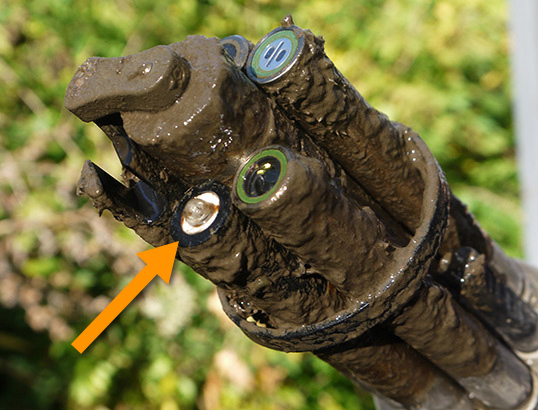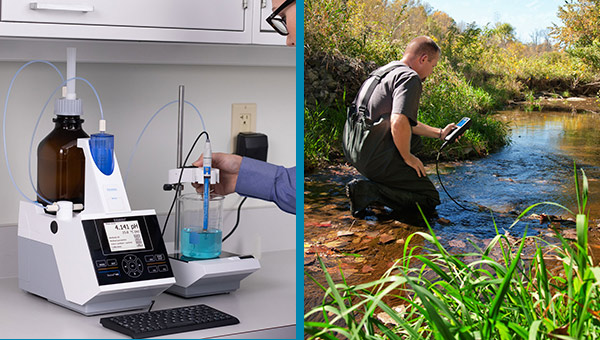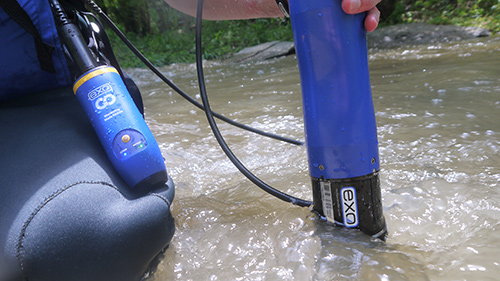Water Quality Monitoring Assumptions
(Updated October 2021)
What are three wrong assumptions people make about water quality monitoring?
As someone who cut her scientific teeth on laboratory instrumentation, I am often amazed that water quality monitoring sondes withstand the harshest of environments while delivering high-quality data, often for months on end. An analytical chemist friend of mine and 10 year veteran of YSI confessed to me at YSI’s Thanksgiving lunch that she’s still in disbelief there is such a thing as a pH sensor that works for 30 days in the environment without daily recalibration. Yet, that’s exactly what it does.
We’ve seen surprising, wonderful things that our technology can do, from our on-site test pond to the Great Barrier Reef.

YSI EXO Sonde preventing biofouling with wiped sensor technology. Even the bulb of the pH sensor is wiped clean of fouling.
However…
We’ve also seen some things that sonde technology can’t do. Occasionally I encounter users who are doing really cool stuff, but who are perplexed that the data don’t look “how they’re supposed to.” What I’ve learned is that this is rarely due to a malfunctioning instrument, miscalibration, or any of the many things that people start to investigate regarding the instrument itself. Rather, it is almost always due to expectations being misaligned with the technology, due to some assumptions they’ve made.
Thus let’s explore the three most problematic assumptions people make about water quality monitoring, based on my years of experience in both the laboratory and the field.
Assumption #1 - Field Data Should Look Like Lab Data

Laboratory vs Field Sampling Conditions are not the same.
In a previous blog, I addressed the five questions I get most often about harmful algal bloom (HAB) monitoring. (Learn more, Answers to the Top Five HAB Monitoring Questions). Answer number 4 addresses the question “Why don’t my lab chlorophyll extraction data match up with the chlorophyll numbers from the sondes?” You can go there for my complete answer, but one statement pretty much sums it up:
“…the correlation between the sensor’s mV signals and µg/L [of pigment] delivered by the sensors was built using one species of algae which were grown in a laboratory under highly controlled conditions that included a never-changing light intensity and duty cycle. Thus one should not expect that all algae, under all conditions, would yield the same correlation.”
There are other reasons that the field vs. lab data assumption is dangerous, and one of the most important regards sample processing.
All properly-trained scientists understand the challenge of collecting a sample that is truly representative of a population, and further, how that sample is collected and processed for analysis can have a major impact on the final measurements and conclusions. For example, in the case of chlorophyll analyses, the time of day and depth at which you collect can matter, there is typically an extraction with an organic solvent (acetone or methanol), and the pigment is measured on a fluorometer or spectrophotometer. In some cases, the pigment may even be separated from other components in the extract using chromatography.
In the field…? No extraction, different matrix (water rather than solvent), different matrix quality (lab samples are typically filtered/separated), and so forth.
In other words, the sensor is sensing pigment in the environment, and twice the sensor output is representative of twice the amount of pigment sensed within its operating range, but it is not the same as the measurement of pigment in a laboratory, and shouldn’t be treated as such.
Let’s expand this thinking to other sensors. In my opinion, optical sensors (turbidity, fDOM, total algae) are the most prone to these misaligned expectations, but pH sensors, temperature and conductivity sensors are generally spot-on relative to what you’d get with laboratory instrumentation. Carry through on the thinking for how one would measure these things in a laboratory vs. the environment (different instrumentation), how samples are handled, the matrix, etc. and I think it will be apparent that in some cases sensors and lab analyses will line up pretty well, in some cases they won’t. Alignment with laboratory analyses is influenced by how these sensors work, which you can learn more about in our How Sensors Work webinar series. (Visit Webinar Series: How Sensors Work)
The EXO dissolved oxygen sensor, which is an optical sensor that works more like an opto-chemical assay rather than direct absorption or fluorescence of an analyte, is somewhere in between these others. It is diffusion-based, so things that affect diffusion in the real-world environment come into play. Some of those things may be used to correct the DO measurement (e.g., salinity and barometric pressure), but some are simply not going to be able to be managed in the environment (e.g., things that might impact the polarity of the environment).
The most egregious example of misaligned expectations I’ve seen with the EXO DO sensor is when people try to extrapolate BOD or COD from their environmental monitoring. Talk about not recognizing the importance of sample prep! (Learn more, BOD Testing Accuracy and Success - Are You Achieving This?)
In all cases, one must develop an understanding of how any sensor’s output correlates to bench analyses that the scientific community has established as “gold standards” or that your own laboratory uses for its studies. That brings us to our second assumption below.
Assumption #2 - Sondes are All You Need for Monitoring Water Quality
We sell sondes. Why on Earth would I argue if that’s all you want to use?
Much of what has been said about assumption #1 above should already make it apparent why #2 is a poor assumption to make, particularly when people start drawing conclusions that are viable when based upon laboratory measurements, but not necessarily when based upon monitoring with sensors in the environment. Thus I’ll argue because if you don’t get good outcomes, it’s not good for anybody!
If one is going to make the investment in a sonde it should be viewed as an investment in a program, not just an instrument. It is a commitment to some objective you want to achieve. It is quite possible that the sonde is all you need to achieve that objective, but in my experience sonde data are most valuable when supplemented with laboratory analyses, spot sampling measurements, measured outcomes from some process or operation (in the case of drinking water sources, for example), or even eyes on the water to see which sensor outputs align with which features that people care about (e.g., odor or color of the water).
Define your objectives first, choose your technology and approach second. Don’t choose your technology and then build your objectives around what you perceive it is capable of.
As Gary John Bishop states in his book Stop Doing that Sh*t, "Your actions match your conclusions".
Assumption #3 - An Accuracy Specification is the Accuracy of Their Measurements in the Field
I saved this one for last because it’s the hardest one for me to write about. But as a scientist, I must face this very uncomfortable reality:
After reading about assumptions #1 and #2 above this reality and its implications might be dawning on you, too.
In the environment, where the conditions are not reproducible and in fact are often highly variable (why else would you be monitoring, after all?) the accuracy of measurements may not be the same as the sensor specification for accuracy.
Further, the accuracy may not be the same across the entire operating range of the instrument (e.g., across the entire depth range or the entire temperature range). While it’s known that the sensor and sonde will work across its entire operating range, one can’t necessarily determine accuracy under all possible conditions.
There simply is no way that we can simulate all possible cases in the laboratory, in order to develop corrective algorithms for the interferences and conditions that a sensor will be exposed to in the environment. A super-simple way to think about this if you’re familiar with a laboratory spectrophotometer, for example, is that for the environment, we can’t make a blank.
The relationship between the accuracy specification and the real accuracy measured in the environment depends not only upon the environmental influences but also it depends upon the type of sensor (fluorescence-based? Diffusion-based? etc.), how it is designed and with what materials (yes, the manufacturer matters!), what application it was designed for (can’t use your lab pH probe in the environment after all), and the extent to which internal firmware can compensate for some anticipated and well-understood interferences, often using readings of other sensors. That’s one of the reasons a multiparameter platform like EXO, ProDSS, or ProQuatro is so valuable.
So why do we even bother to provide an accuracy specification? Well, we have to start somewhere to describe our technologies, and to provide a basis for comparison of competing or alternative technologies. We also need a baseline to gauge improvements in our technologies during development, and in some cases, we test that accuracy across as wide a range of conditions as possible so that we understand the robustness of the technology for environmental monitoring.
If you are panicking, thinking that there simply is no way to get a decent measurement from water quality monitoring, don’t throw away thousands of dollars worth of equipment and change your career to banking quite yet. I can assure you that like my friend the chemist who chatted with me over Thanksgiving potluck, you will be amazed when you really pay attention to just how well the sensors work, and how they compare to data from grab samples or your own sensor-to-lab method correlations that you build.
I could write volumes on this topic, and it’s so important that I’ve pondered writing a review article on it. I would welcome volunteers who are interested in experimentation and co-authorship of a paper—comment on this blog or my Twitter page (@WaterWoman).
In closing, my sincerest wish is that by pointing out these three flawed assumptions, our customers will collect the best data possible for the best programs possible.

Additional Blog Posts of Interest
5 Tips to Prevent Costly Mistakes with You Water Quality Sonde
How to Overcome 5 Water Quality Monitoring Challenges
7 Tips to Fight Fouling and Extend Water Quality Sonde Deployments
How to Take Care of Your New EXO Sonde